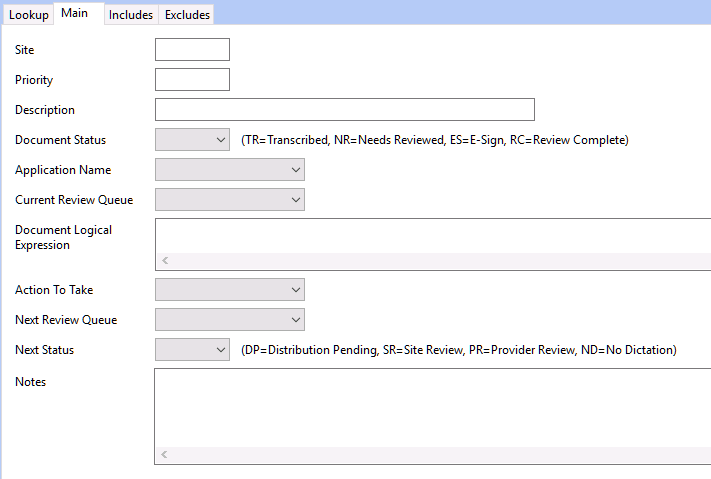
The Main tab is where all the pertinent information about how you want documents to be routed through the system.
INACTIVE: In the upper right hand corner of this tab there is a checkbox to mark a workflow inactive. This is useful if you want to troubleshoot an issue or had a complex rule setup that is no longer needed, but you may want to save for future use.
SITE: If this workflow rule is for a specific site only, enter the site number. If this rule will apply to all documents then leave this blank. Remember that site workflow rules will be followed before without a site code.
PRIORITY: The system will route documents based the following number from 1 to 9999.
1st route check all site specific routes. The system will then process a workflow based on the priority from lowest to highest, meaning that 100 will process before 150.
DESCRIPTION: Enter a description for this workflow rule
REPORT STATUS: This is the current status the document is on when it reaches the system. There are 4 different status options for a workflow rule to be processed on: TR = Transcribed; NR = Needs Reviewed; ES = On Esign; RC = Review complete
For example: If you have a document that is in transcribed status that needs to go to review based on what is in the logical expression field.
APPLICATION NAME: This is the current application that processed the document. This will always be blank unless utilizing voice recognition or report import.
CURRENT REVIEW QUEUE: When a document matches this reviewed queue and the status is changing to RC (Review Complete) it will follow this workflow. This is commonly used for documents that are on a certain review queue and the next step would be to go to another review queue or to site review.
REPORT LOGICAL EXPRESSION: This is the logic where the system will process documents matching what is in the expression. The system utilizes the report index table. For a list of fields, please refer to the Appendix. Expressions that return true will process the workflow.
Some examples:
•Notes<> Null
if the field “notes” is empty it will process the rule
•MISSINGDAT=.T.
The document contains missing data in the RDS
•INCOMPLETE=.T.
The document contains an incomplete marker (Ctrl-G)
in the document <INC:00:00:00>
•MISSINGDAT=.T. AND PREVSTATUS<>"SR"
The document contains missing data in the RDS AND the document is
not currently on “Site Review” Status
•(INCOMPLETE=.T.) OR (MISSINGDAT=.T.)
The document has EITHER missing data in the RDS or an
incomplete marker in the document.
•(DISDT=NULL)
| The document has no value in the Discharge Date field on the RDS. The DISDT field is set to Not Required so a NULL value is possible. |
Note: Everything above the logical expression is how to identify the document – everything after is what happens to the document.
ACTION TO TAKE:
Change Queue: The system will update the document review queue.
Change Status: The system will update the document status.
Nothing: The system will not do anything – The document will proceed to normal distribution workflow. This can be useful for troubleshooting.
NEXT REVIEW QUEUE: All review queues are an option.
If you have selected “Change Queue” in action to take, you need to select a review queue from the list.
NEXT STATUS: If you have selected “Change Status” in action to take, you need to select one of the following statuses:DP = Distribution Pending; SR= Site Review; PR= Provider Review;ND = No Dictation
NOTES: This is so the user can add notes/documentation as to why this rule was created.
NOTE: Site Review must be enabled at the site level. Provider review must be setup in the provider and site user for this to function properly. (See provider / user instructions)